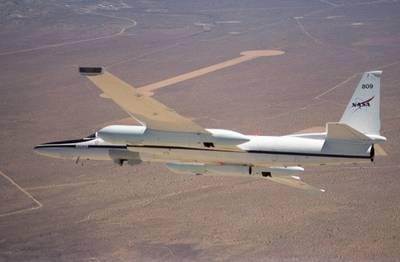Sat, Jul 16, 2005
Nasa's Tropical Cloud Systems And Processes Mission In Costa
Rica
 In the wake of Hurricane Dennis,
NASA and the National Oceanic and Atmospheric Administration (NOAA)
are busy studying data gathered during the early days of the
hurricane that threatened much of the southern Atlantic and Gulf of
Mexico.
In the wake of Hurricane Dennis,
NASA and the National Oceanic and Atmospheric Administration (NOAA)
are busy studying data gathered during the early days of the
hurricane that threatened much of the southern Atlantic and Gulf of
Mexico.
Researchers conducted their second coordinated flight to study
Tropical Storm Dennis on the evening of July 6. The ER-2 overflew
the developing eye and "rain bands" of the tropical storm using
coordinates relayed by the TCSP science team monitoring satellite
imagery on the ground. The ER-2, which flew at 65,000 feet, was
joined a few hours later by the NOAA P-3 Orion, flying at 14,000
feet. During the mission, the National Hurricane Center upgraded
Tropical Storm Dennis to Hurricane Dennis at Category 1
intensity.
The NASA and NOAA planes flew coordinated passes over the eye of
the storm for more than an hour. Both aircraft monitored
precipitation structures as the eye became more tightly concentric,
and rain bands increased in intensity with each pass. The P-3 Orion
continued to monitor the storm's eye wall and rain band development
for several more hours after the ER-2 returned to base, making five
passes over the eye. At one point, the storm pressure dropped 12
millibars in a two-hour period -- equivalent to the amount that a
garden-variety low pressure system over the United States may
intensify in about 24 hours.
The TCSP missions to document developing tropical cyclones are
providing rare datasets that will help unravel the mysteries about
why so few tropical weather disturbances intensify into
full-fledged hurricanes. For instance, "rapid deepening" -- a
phenomenon in which the minimum sea-level pressure of a tropical
cyclone drops by 1.75 millibars per hour, or 42 millibars in 24
hours -- is still poorly understood and is not captured well by
hurricane forecast models. In the case of Dennis, the data captured
exceptionally rapid deepening of the storm's central pressure, as
well as documenting the eye in the process of closing off into a
complete circle.

The 28-day TCSP mission is sponsored by NASA's Science Mission
Directorate at NASA Headquarters in Washington. The primary goal of
the mission is to document "cyclogenesis" in action -- the
interaction of temperature, humidity, precipitation, wind and air
pressure that creates ideal birthing conditions for tropical
storms, hurricanes and related phenomena.
More News
Improvements Stack as Brand Readies for Mass Production Samson Sky updated followers on its flying car progress, describing some of the travails of the wind tunnel as they get clos>[...]
LAHSO An acronym for “Land and Hold Short Operation.” These operations include landing and holding short of an intersecting runway, a taxiway, a predetermined point, or>[...]
Dave Juwel's Aviation Marketing Stories ITBOA BNITBOB ... what does that mean? It's not gibberish, it's a lengthy acronym for "In The Business Of Aviation ... But Not In The Busine>[...]
Aero Linx: Space Medicine Association (SMA) The Space Medicine Branch was founded in 1951 as the first constituent organization of the Aerospace Medical Association (AsMA). In 2006>[...]
Back-Taxi A term used by air traffic controllers to taxi an aircraft on the runway opposite to the traffic flow. The aircraft may be instructed to back-taxi to the beginning of the>[...]
 Samson Sky Hits the Wind Tunnel
Samson Sky Hits the Wind Tunnel ANN's Daily Aero-Term (05.22.24): LAHSO
ANN's Daily Aero-Term (05.22.24): LAHSO Aero-FAQ: Dave Juwel's Aviation Marketing Stories -- ITBOA BNITBOB
Aero-FAQ: Dave Juwel's Aviation Marketing Stories -- ITBOA BNITBOB ANN's Daily Aero-Linx (05.19.24)
ANN's Daily Aero-Linx (05.19.24) ANN's Daily Aero-Term (05.19.24): Back-Taxi
ANN's Daily Aero-Term (05.19.24): Back-Taxi




